Impact of Training & Development on Employee Output: A UK Study
VerifiedAdded on 2023/06/16
|28
|7523
|404
Thesis and Dissertation
AI Summary
This dissertation investigates the impact of training and development on employee performance within the consumer goods industry, focusing on Companies 1, 2, and 3 in the United Kingdom. It assesses employee output based on product and service quality and quantity, examining how effectively employees fulfill responsibilities, complete tasks, and meet objectives. The research employs a literature review, exploring theoretical frameworks, measures of employee output (including employee objectives, manager assessments, and balanced scorecards), and various training and development methods like role-playing and on-the-job training. Key impacts of training and development, such as enhanced productivity, closure of performance gaps, improved financial performance, increased employee motivation, a better understanding of company objectives, and employee development, are analyzed, along with the relationship between training and worker output, emphasizing customer prioritization and creativity boosts. Desklib provides access to this document and many more resources for students.
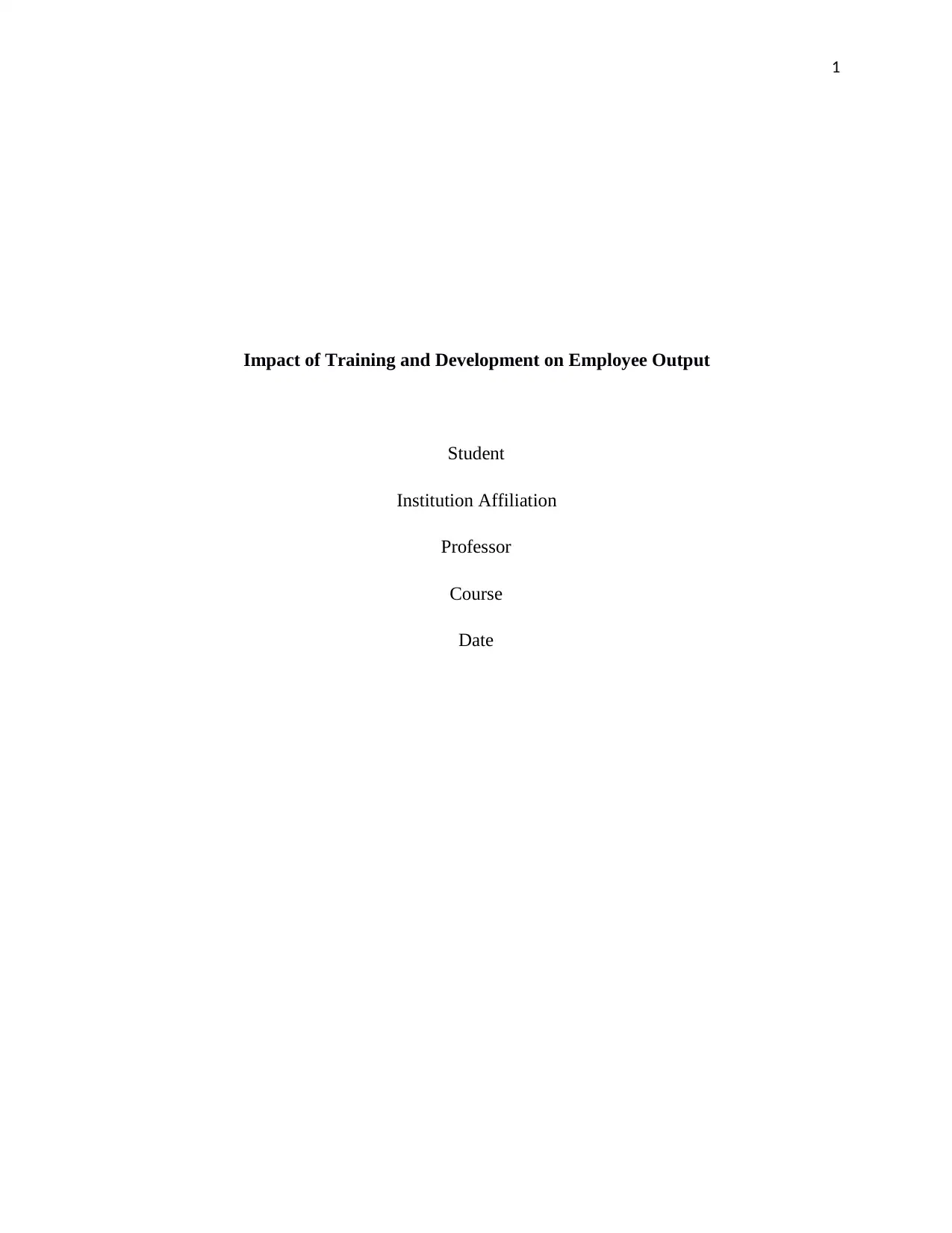
1
Impact of Training and Development on Employee Output
Student
Institution Affiliation
Professor
Course
Date
Impact of Training and Development on Employee Output
Student
Institution Affiliation
Professor
Course
Date
Paraphrase This Document
Need a fresh take? Get an instant paraphrase of this document with our AI Paraphraser
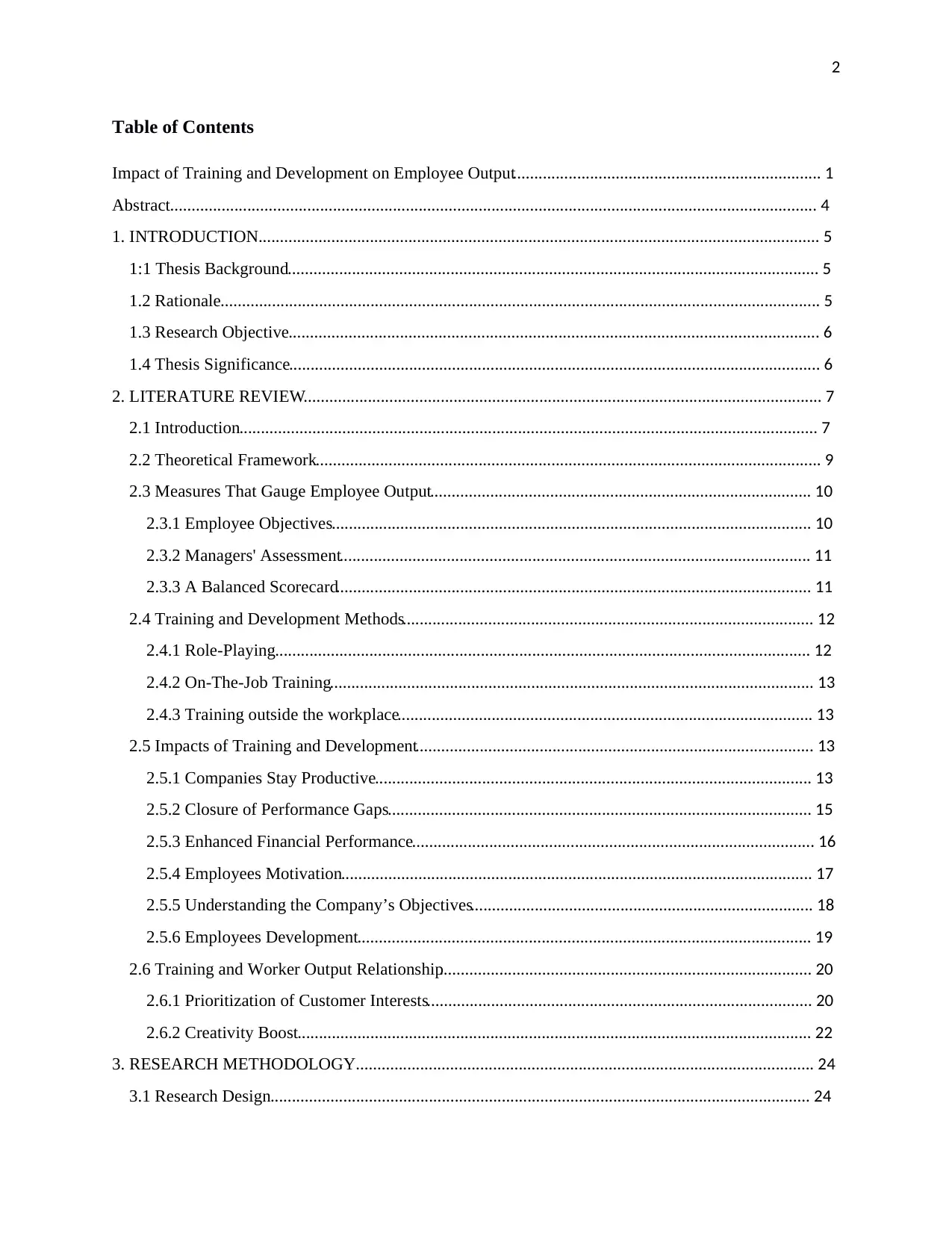
2
Table of Contents
Impact of Training and Development on Employee Output........................................................................ 1
Abstract....................................................................................................................................................... 4
1. INTRODUCTION................................................................................................................................... 5
1:1 Thesis Background............................................................................................................................ 5
1.2 Rationale............................................................................................................................................ 5
1.3 Research Objective............................................................................................................................ 6
1.4 Thesis Significance............................................................................................................................ 6
2. LITERATURE REVIEW......................................................................................................................... 7
2.1 Introduction....................................................................................................................................... 7
2.2 Theoretical Framework...................................................................................................................... 9
2.3 Measures That Gauge Employee Output......................................................................................... 10
2.3.1 Employee Objectives................................................................................................................ 10
2.3.2 Managers' Assessment.............................................................................................................. 11
2.3.3 A Balanced Scorecard............................................................................................................... 11
2.4 Training and Development Methods................................................................................................ 12
2.4.1 Role-Playing............................................................................................................................. 12
2.4.2 On-The-Job Training................................................................................................................. 13
2.4.3 Training outside the workplace................................................................................................. 13
2.5 Impacts of Training and Development............................................................................................. 13
2.5.1 Companies Stay Productive...................................................................................................... 13
2.5.2 Closure of Performance Gaps................................................................................................... 15
2.5.3 Enhanced Financial Performance.............................................................................................. 16
2.5.4 Employees Motivation.............................................................................................................. 17
2.5.5 Understanding the Company’s Objectives................................................................................ 18
2.5.6 Employees Development.......................................................................................................... 19
2.6 Training and Worker Output Relationship....................................................................................... 20
2.6.1 Prioritization of Customer Interests.......................................................................................... 20
2.6.2 Creativity Boost........................................................................................................................ 22
3. RESEARCH METHODOLOGY........................................................................................................... 24
3.1 Research Design.............................................................................................................................. 24
Table of Contents
Impact of Training and Development on Employee Output........................................................................ 1
Abstract....................................................................................................................................................... 4
1. INTRODUCTION................................................................................................................................... 5
1:1 Thesis Background............................................................................................................................ 5
1.2 Rationale............................................................................................................................................ 5
1.3 Research Objective............................................................................................................................ 6
1.4 Thesis Significance............................................................................................................................ 6
2. LITERATURE REVIEW......................................................................................................................... 7
2.1 Introduction....................................................................................................................................... 7
2.2 Theoretical Framework...................................................................................................................... 9
2.3 Measures That Gauge Employee Output......................................................................................... 10
2.3.1 Employee Objectives................................................................................................................ 10
2.3.2 Managers' Assessment.............................................................................................................. 11
2.3.3 A Balanced Scorecard............................................................................................................... 11
2.4 Training and Development Methods................................................................................................ 12
2.4.1 Role-Playing............................................................................................................................. 12
2.4.2 On-The-Job Training................................................................................................................. 13
2.4.3 Training outside the workplace................................................................................................. 13
2.5 Impacts of Training and Development............................................................................................. 13
2.5.1 Companies Stay Productive...................................................................................................... 13
2.5.2 Closure of Performance Gaps................................................................................................... 15
2.5.3 Enhanced Financial Performance.............................................................................................. 16
2.5.4 Employees Motivation.............................................................................................................. 17
2.5.5 Understanding the Company’s Objectives................................................................................ 18
2.5.6 Employees Development.......................................................................................................... 19
2.6 Training and Worker Output Relationship....................................................................................... 20
2.6.1 Prioritization of Customer Interests.......................................................................................... 20
2.6.2 Creativity Boost........................................................................................................................ 22
3. RESEARCH METHODOLOGY........................................................................................................... 24
3.1 Research Design.............................................................................................................................. 24
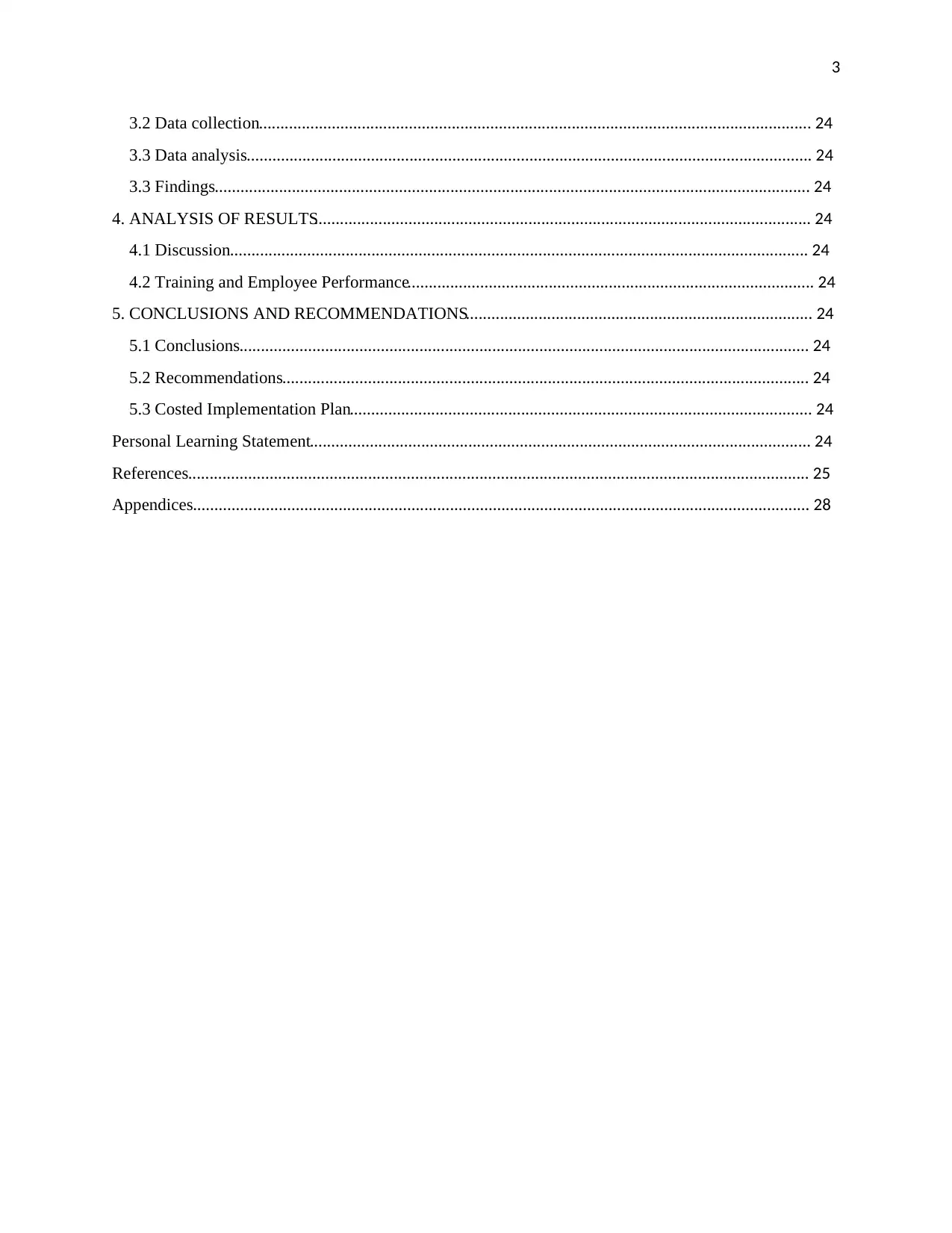
3
3.2 Data collection................................................................................................................................. 24
3.3 Data analysis.................................................................................................................................... 24
3.3 Findings........................................................................................................................................... 24
4. ANALYSIS OF RESULTS.................................................................................................................... 24
4.1 Discussion....................................................................................................................................... 24
4.2 Training and Employee Performance............................................................................................... 24
5. CONCLUSIONS AND RECOMMENDATIONS................................................................................. 24
5.1 Conclusions..................................................................................................................................... 24
5.2 Recommendations........................................................................................................................... 24
5.3 Costed Implementation Plan............................................................................................................ 24
Personal Learning Statement..................................................................................................................... 24
References................................................................................................................................................. 25
Appendices................................................................................................................................................ 28
3.2 Data collection................................................................................................................................. 24
3.3 Data analysis.................................................................................................................................... 24
3.3 Findings........................................................................................................................................... 24
4. ANALYSIS OF RESULTS.................................................................................................................... 24
4.1 Discussion....................................................................................................................................... 24
4.2 Training and Employee Performance............................................................................................... 24
5. CONCLUSIONS AND RECOMMENDATIONS................................................................................. 24
5.1 Conclusions..................................................................................................................................... 24
5.2 Recommendations........................................................................................................................... 24
5.3 Costed Implementation Plan............................................................................................................ 24
Personal Learning Statement..................................................................................................................... 24
References................................................................................................................................................. 25
Appendices................................................................................................................................................ 28
⊘ This is a preview!⊘
Do you want full access?
Subscribe today to unlock all pages.

Trusted by 1+ million students worldwide
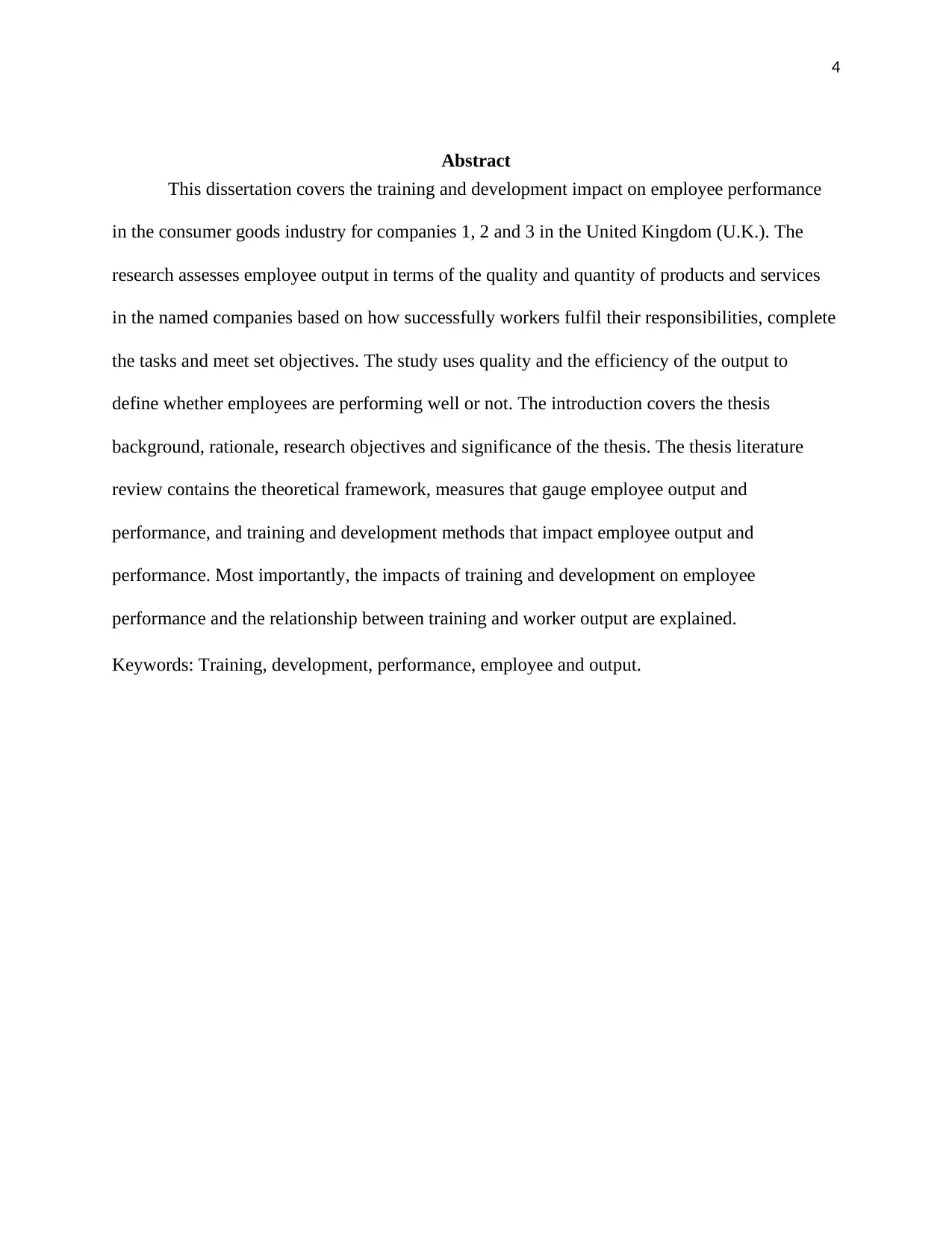
4
Abstract
This dissertation covers the training and development impact on employee performance
in the consumer goods industry for companies 1, 2 and 3 in the United Kingdom (U.K.). The
research assesses employee output in terms of the quality and quantity of products and services
in the named companies based on how successfully workers fulfil their responsibilities, complete
the tasks and meet set objectives. The study uses quality and the efficiency of the output to
define whether employees are performing well or not. The introduction covers the thesis
background, rationale, research objectives and significance of the thesis. The thesis literature
review contains the theoretical framework, measures that gauge employee output and
performance, and training and development methods that impact employee output and
performance. Most importantly, the impacts of training and development on employee
performance and the relationship between training and worker output are explained.
Keywords: Training, development, performance, employee and output.
Abstract
This dissertation covers the training and development impact on employee performance
in the consumer goods industry for companies 1, 2 and 3 in the United Kingdom (U.K.). The
research assesses employee output in terms of the quality and quantity of products and services
in the named companies based on how successfully workers fulfil their responsibilities, complete
the tasks and meet set objectives. The study uses quality and the efficiency of the output to
define whether employees are performing well or not. The introduction covers the thesis
background, rationale, research objectives and significance of the thesis. The thesis literature
review contains the theoretical framework, measures that gauge employee output and
performance, and training and development methods that impact employee output and
performance. Most importantly, the impacts of training and development on employee
performance and the relationship between training and worker output are explained.
Keywords: Training, development, performance, employee and output.
Paraphrase This Document
Need a fresh take? Get an instant paraphrase of this document with our AI Paraphraser
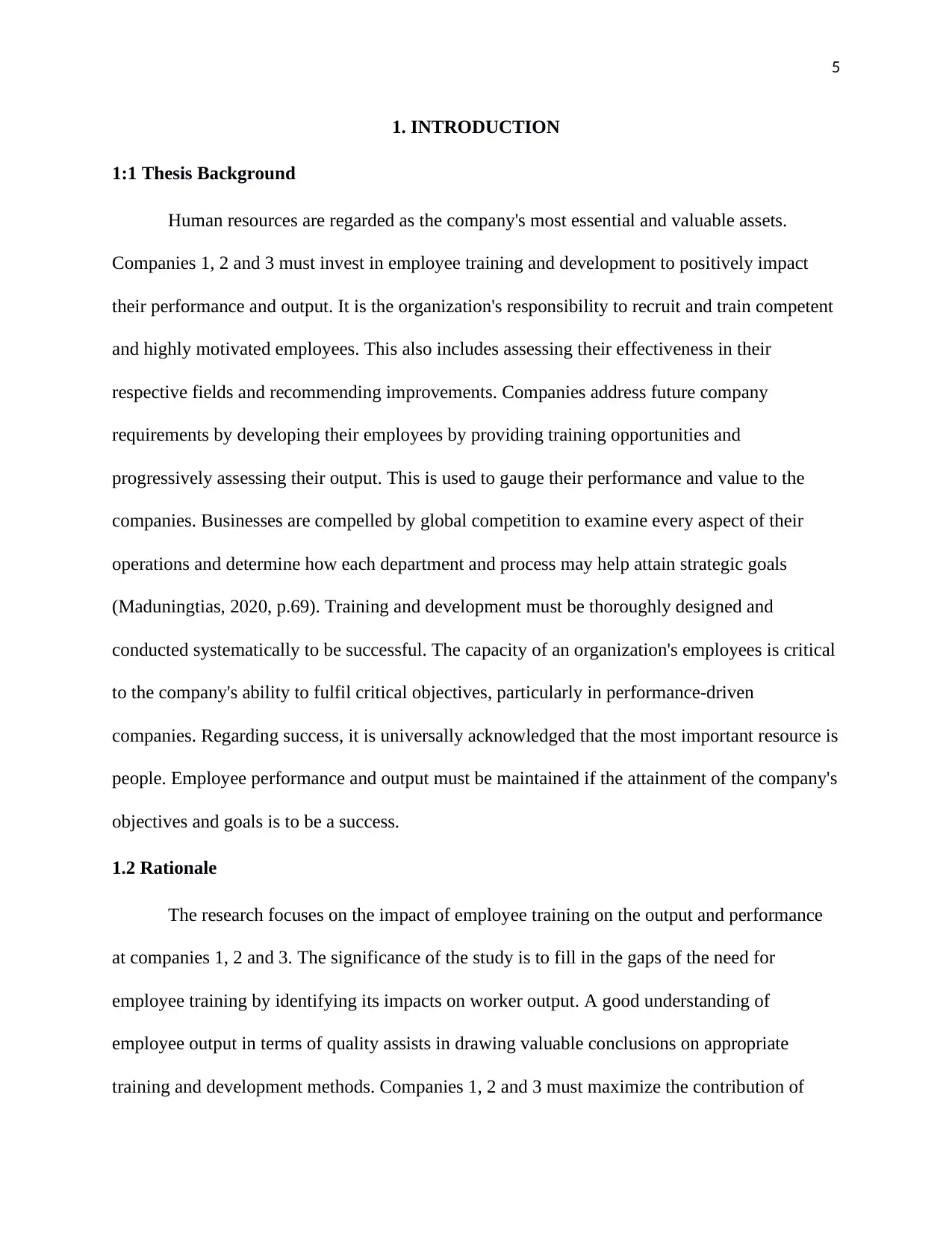
5
1. INTRODUCTION
1:1 Thesis Background
Human resources are regarded as the company's most essential and valuable assets.
Companies 1, 2 and 3 must invest in employee training and development to positively impact
their performance and output. It is the organization's responsibility to recruit and train competent
and highly motivated employees. This also includes assessing their effectiveness in their
respective fields and recommending improvements. Companies address future company
requirements by developing their employees by providing training opportunities and
progressively assessing their output. This is used to gauge their performance and value to the
companies. Businesses are compelled by global competition to examine every aspect of their
operations and determine how each department and process may help attain strategic goals
(Maduningtias, 2020, p.69). Training and development must be thoroughly designed and
conducted systematically to be successful. The capacity of an organization's employees is critical
to the company's ability to fulfil critical objectives, particularly in performance-driven
companies. Regarding success, it is universally acknowledged that the most important resource is
people. Employee performance and output must be maintained if the attainment of the company's
objectives and goals is to be a success.
1.2 Rationale
The research focuses on the impact of employee training on the output and performance
at companies 1, 2 and 3. The significance of the study is to fill in the gaps of the need for
employee training by identifying its impacts on worker output. A good understanding of
employee output in terms of quality assists in drawing valuable conclusions on appropriate
training and development methods. Companies 1, 2 and 3 must maximize the contribution of
1. INTRODUCTION
1:1 Thesis Background
Human resources are regarded as the company's most essential and valuable assets.
Companies 1, 2 and 3 must invest in employee training and development to positively impact
their performance and output. It is the organization's responsibility to recruit and train competent
and highly motivated employees. This also includes assessing their effectiveness in their
respective fields and recommending improvements. Companies address future company
requirements by developing their employees by providing training opportunities and
progressively assessing their output. This is used to gauge their performance and value to the
companies. Businesses are compelled by global competition to examine every aspect of their
operations and determine how each department and process may help attain strategic goals
(Maduningtias, 2020, p.69). Training and development must be thoroughly designed and
conducted systematically to be successful. The capacity of an organization's employees is critical
to the company's ability to fulfil critical objectives, particularly in performance-driven
companies. Regarding success, it is universally acknowledged that the most important resource is
people. Employee performance and output must be maintained if the attainment of the company's
objectives and goals is to be a success.
1.2 Rationale
The research focuses on the impact of employee training on the output and performance
at companies 1, 2 and 3. The significance of the study is to fill in the gaps of the need for
employee training by identifying its impacts on worker output. A good understanding of
employee output in terms of quality assists in drawing valuable conclusions on appropriate
training and development methods. Companies 1, 2 and 3 must maximize the contribution of
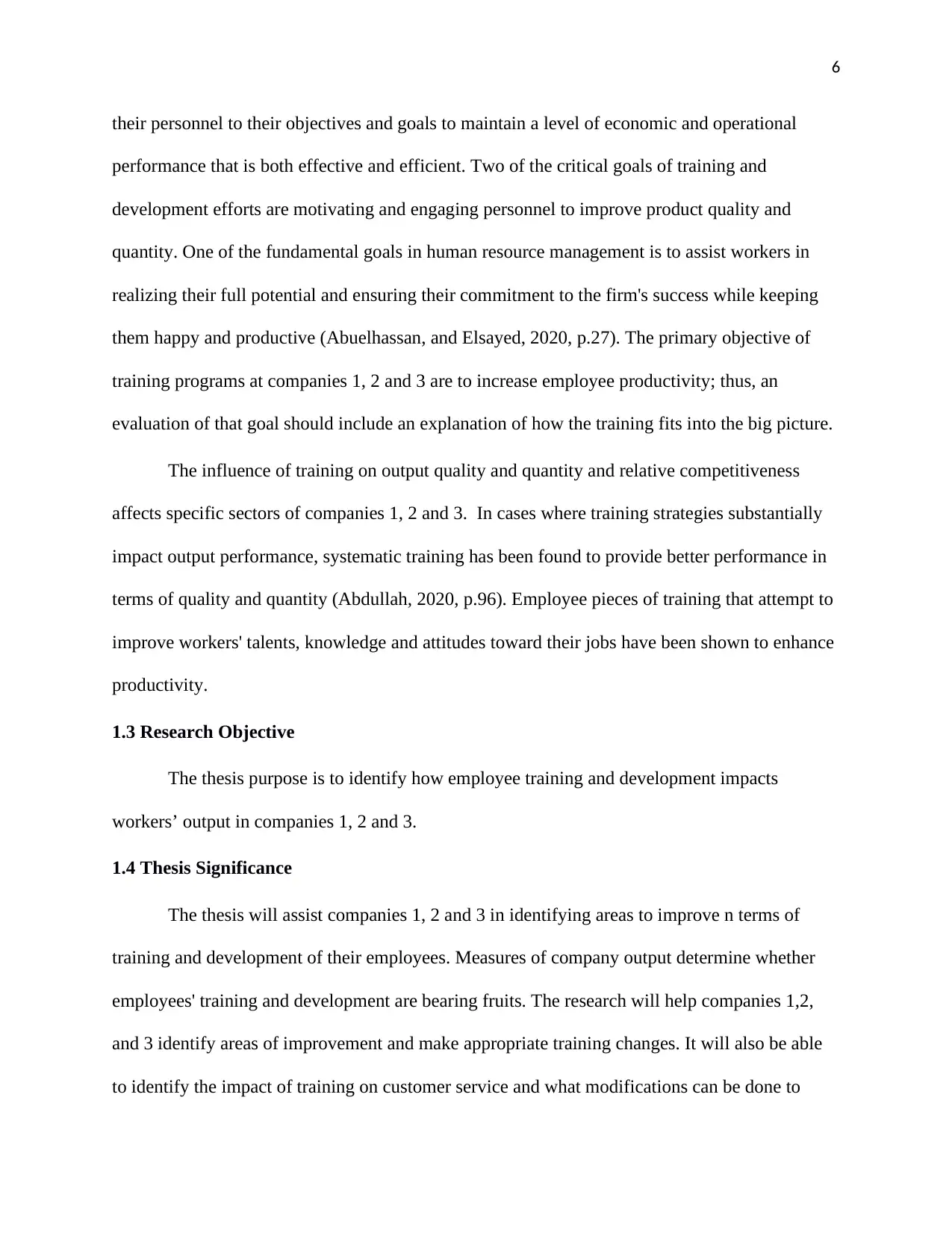
6
their personnel to their objectives and goals to maintain a level of economic and operational
performance that is both effective and efficient. Two of the critical goals of training and
development efforts are motivating and engaging personnel to improve product quality and
quantity. One of the fundamental goals in human resource management is to assist workers in
realizing their full potential and ensuring their commitment to the firm's success while keeping
them happy and productive (Abuelhassan, and Elsayed, 2020, p.27). The primary objective of
training programs at companies 1, 2 and 3 are to increase employee productivity; thus, an
evaluation of that goal should include an explanation of how the training fits into the big picture.
The influence of training on output quality and quantity and relative competitiveness
affects specific sectors of companies 1, 2 and 3. In cases where training strategies substantially
impact output performance, systematic training has been found to provide better performance in
terms of quality and quantity (Abdullah, 2020, p.96). Employee pieces of training that attempt to
improve workers' talents, knowledge and attitudes toward their jobs have been shown to enhance
productivity.
1.3 Research Objective
The thesis purpose is to identify how employee training and development impacts
workers’ output in companies 1, 2 and 3.
1.4 Thesis Significance
The thesis will assist companies 1, 2 and 3 in identifying areas to improve n terms of
training and development of their employees. Measures of company output determine whether
employees' training and development are bearing fruits. The research will help companies 1,2,
and 3 identify areas of improvement and make appropriate training changes. It will also be able
to identify the impact of training on customer service and what modifications can be done to
their personnel to their objectives and goals to maintain a level of economic and operational
performance that is both effective and efficient. Two of the critical goals of training and
development efforts are motivating and engaging personnel to improve product quality and
quantity. One of the fundamental goals in human resource management is to assist workers in
realizing their full potential and ensuring their commitment to the firm's success while keeping
them happy and productive (Abuelhassan, and Elsayed, 2020, p.27). The primary objective of
training programs at companies 1, 2 and 3 are to increase employee productivity; thus, an
evaluation of that goal should include an explanation of how the training fits into the big picture.
The influence of training on output quality and quantity and relative competitiveness
affects specific sectors of companies 1, 2 and 3. In cases where training strategies substantially
impact output performance, systematic training has been found to provide better performance in
terms of quality and quantity (Abdullah, 2020, p.96). Employee pieces of training that attempt to
improve workers' talents, knowledge and attitudes toward their jobs have been shown to enhance
productivity.
1.3 Research Objective
The thesis purpose is to identify how employee training and development impacts
workers’ output in companies 1, 2 and 3.
1.4 Thesis Significance
The thesis will assist companies 1, 2 and 3 in identifying areas to improve n terms of
training and development of their employees. Measures of company output determine whether
employees' training and development are bearing fruits. The research will help companies 1,2,
and 3 identify areas of improvement and make appropriate training changes. It will also be able
to identify the impact of training on customer service and what modifications can be done to
⊘ This is a preview!⊘
Do you want full access?
Subscribe today to unlock all pages.

Trusted by 1+ million students worldwide
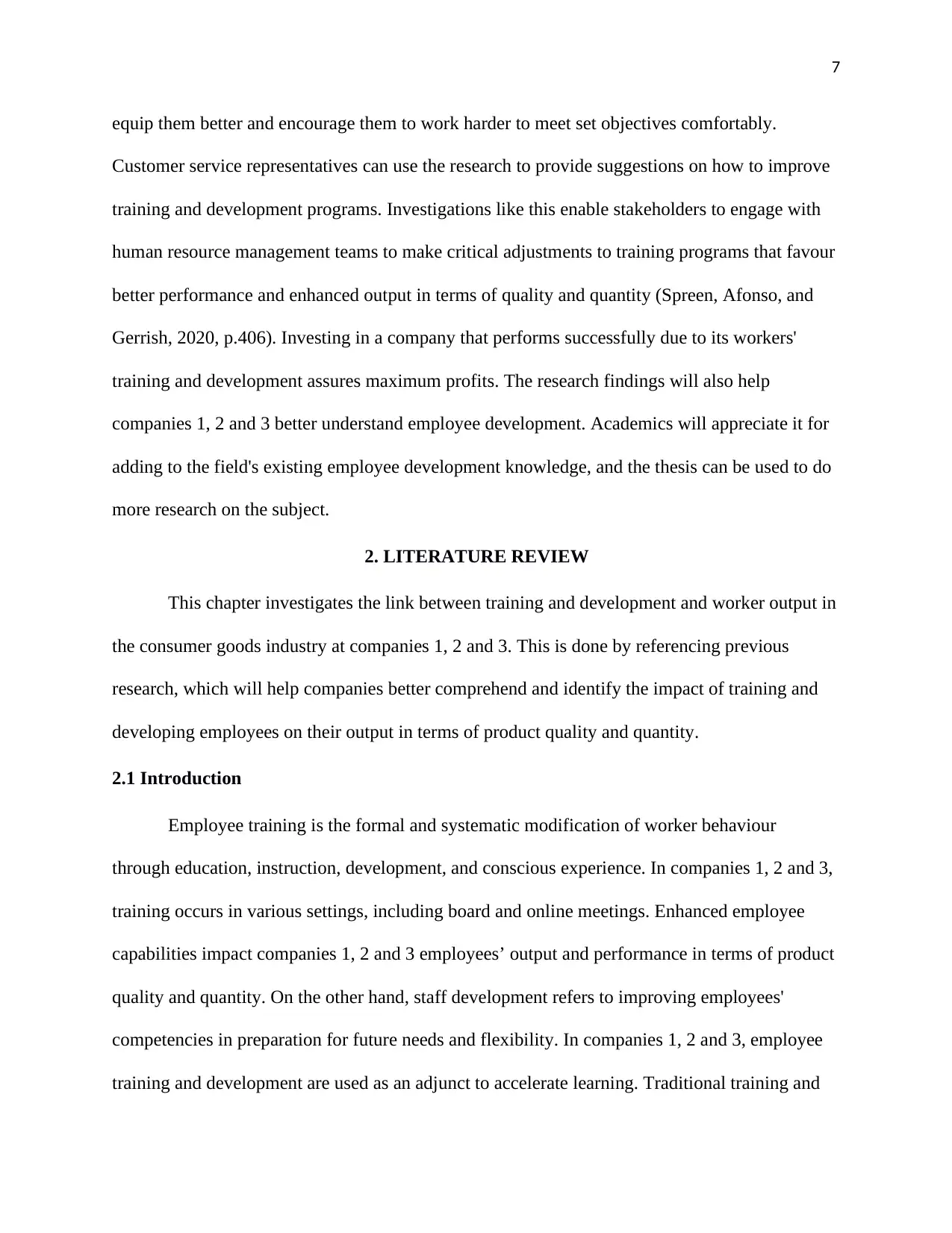
7
equip them better and encourage them to work harder to meet set objectives comfortably.
Customer service representatives can use the research to provide suggestions on how to improve
training and development programs. Investigations like this enable stakeholders to engage with
human resource management teams to make critical adjustments to training programs that favour
better performance and enhanced output in terms of quality and quantity (Spreen, Afonso, and
Gerrish, 2020, p.406). Investing in a company that performs successfully due to its workers'
training and development assures maximum profits. The research findings will also help
companies 1, 2 and 3 better understand employee development. Academics will appreciate it for
adding to the field's existing employee development knowledge, and the thesis can be used to do
more research on the subject.
2. LITERATURE REVIEW
This chapter investigates the link between training and development and worker output in
the consumer goods industry at companies 1, 2 and 3. This is done by referencing previous
research, which will help companies better comprehend and identify the impact of training and
developing employees on their output in terms of product quality and quantity.
2.1 Introduction
Employee training is the formal and systematic modification of worker behaviour
through education, instruction, development, and conscious experience. In companies 1, 2 and 3,
training occurs in various settings, including board and online meetings. Enhanced employee
capabilities impact companies 1, 2 and 3 employees’ output and performance in terms of product
quality and quantity. On the other hand, staff development refers to improving employees'
competencies in preparation for future needs and flexibility. In companies 1, 2 and 3, employee
training and development are used as an adjunct to accelerate learning. Traditional training and
equip them better and encourage them to work harder to meet set objectives comfortably.
Customer service representatives can use the research to provide suggestions on how to improve
training and development programs. Investigations like this enable stakeholders to engage with
human resource management teams to make critical adjustments to training programs that favour
better performance and enhanced output in terms of quality and quantity (Spreen, Afonso, and
Gerrish, 2020, p.406). Investing in a company that performs successfully due to its workers'
training and development assures maximum profits. The research findings will also help
companies 1, 2 and 3 better understand employee development. Academics will appreciate it for
adding to the field's existing employee development knowledge, and the thesis can be used to do
more research on the subject.
2. LITERATURE REVIEW
This chapter investigates the link between training and development and worker output in
the consumer goods industry at companies 1, 2 and 3. This is done by referencing previous
research, which will help companies better comprehend and identify the impact of training and
developing employees on their output in terms of product quality and quantity.
2.1 Introduction
Employee training is the formal and systematic modification of worker behaviour
through education, instruction, development, and conscious experience. In companies 1, 2 and 3,
training occurs in various settings, including board and online meetings. Enhanced employee
capabilities impact companies 1, 2 and 3 employees’ output and performance in terms of product
quality and quantity. On the other hand, staff development refers to improving employees'
competencies in preparation for future needs and flexibility. In companies 1, 2 and 3, employee
training and development are used as an adjunct to accelerate learning. Traditional training and
Paraphrase This Document
Need a fresh take? Get an instant paraphrase of this document with our AI Paraphraser
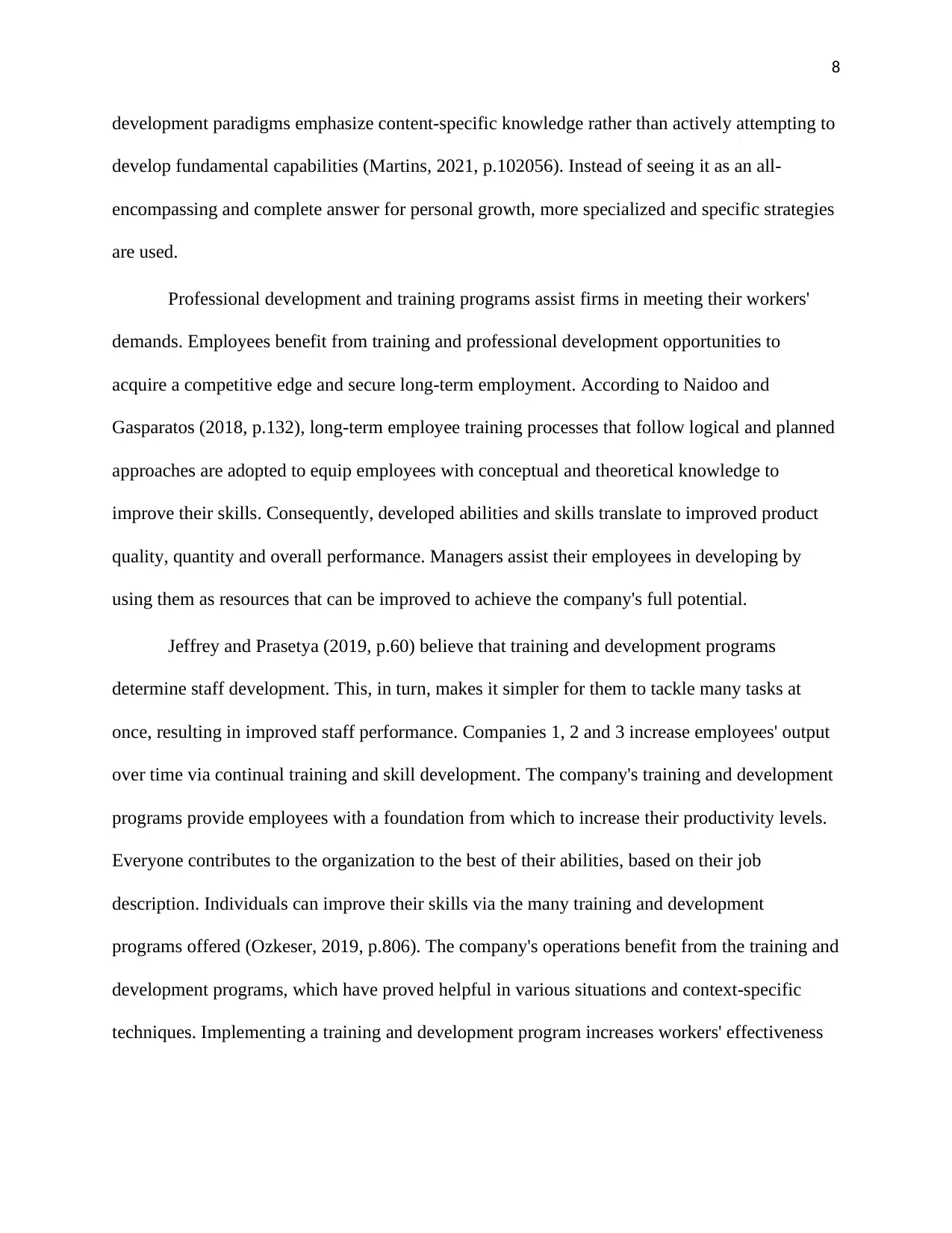
8
development paradigms emphasize content-specific knowledge rather than actively attempting to
develop fundamental capabilities (Martins, 2021, p.102056). Instead of seeing it as an all-
encompassing and complete answer for personal growth, more specialized and specific strategies
are used.
Professional development and training programs assist firms in meeting their workers'
demands. Employees benefit from training and professional development opportunities to
acquire a competitive edge and secure long-term employment. According to Naidoo and
Gasparatos (2018, p.132), long-term employee training processes that follow logical and planned
approaches are adopted to equip employees with conceptual and theoretical knowledge to
improve their skills. Consequently, developed abilities and skills translate to improved product
quality, quantity and overall performance. Managers assist their employees in developing by
using them as resources that can be improved to achieve the company's full potential.
Jeffrey and Prasetya (2019, p.60) believe that training and development programs
determine staff development. This, in turn, makes it simpler for them to tackle many tasks at
once, resulting in improved staff performance. Companies 1, 2 and 3 increase employees' output
over time via continual training and skill development. The company's training and development
programs provide employees with a foundation from which to increase their productivity levels.
Everyone contributes to the organization to the best of their abilities, based on their job
description. Individuals can improve their skills via the many training and development
programs offered (Ozkeser, 2019, p.806). The company's operations benefit from the training and
development programs, which have proved helpful in various situations and context-specific
techniques. Implementing a training and development program increases workers' effectiveness
development paradigms emphasize content-specific knowledge rather than actively attempting to
develop fundamental capabilities (Martins, 2021, p.102056). Instead of seeing it as an all-
encompassing and complete answer for personal growth, more specialized and specific strategies
are used.
Professional development and training programs assist firms in meeting their workers'
demands. Employees benefit from training and professional development opportunities to
acquire a competitive edge and secure long-term employment. According to Naidoo and
Gasparatos (2018, p.132), long-term employee training processes that follow logical and planned
approaches are adopted to equip employees with conceptual and theoretical knowledge to
improve their skills. Consequently, developed abilities and skills translate to improved product
quality, quantity and overall performance. Managers assist their employees in developing by
using them as resources that can be improved to achieve the company's full potential.
Jeffrey and Prasetya (2019, p.60) believe that training and development programs
determine staff development. This, in turn, makes it simpler for them to tackle many tasks at
once, resulting in improved staff performance. Companies 1, 2 and 3 increase employees' output
over time via continual training and skill development. The company's training and development
programs provide employees with a foundation from which to increase their productivity levels.
Everyone contributes to the organization to the best of their abilities, based on their job
description. Individuals can improve their skills via the many training and development
programs offered (Ozkeser, 2019, p.806). The company's operations benefit from the training and
development programs, which have proved helpful in various situations and context-specific
techniques. Implementing a training and development program increases workers' effectiveness
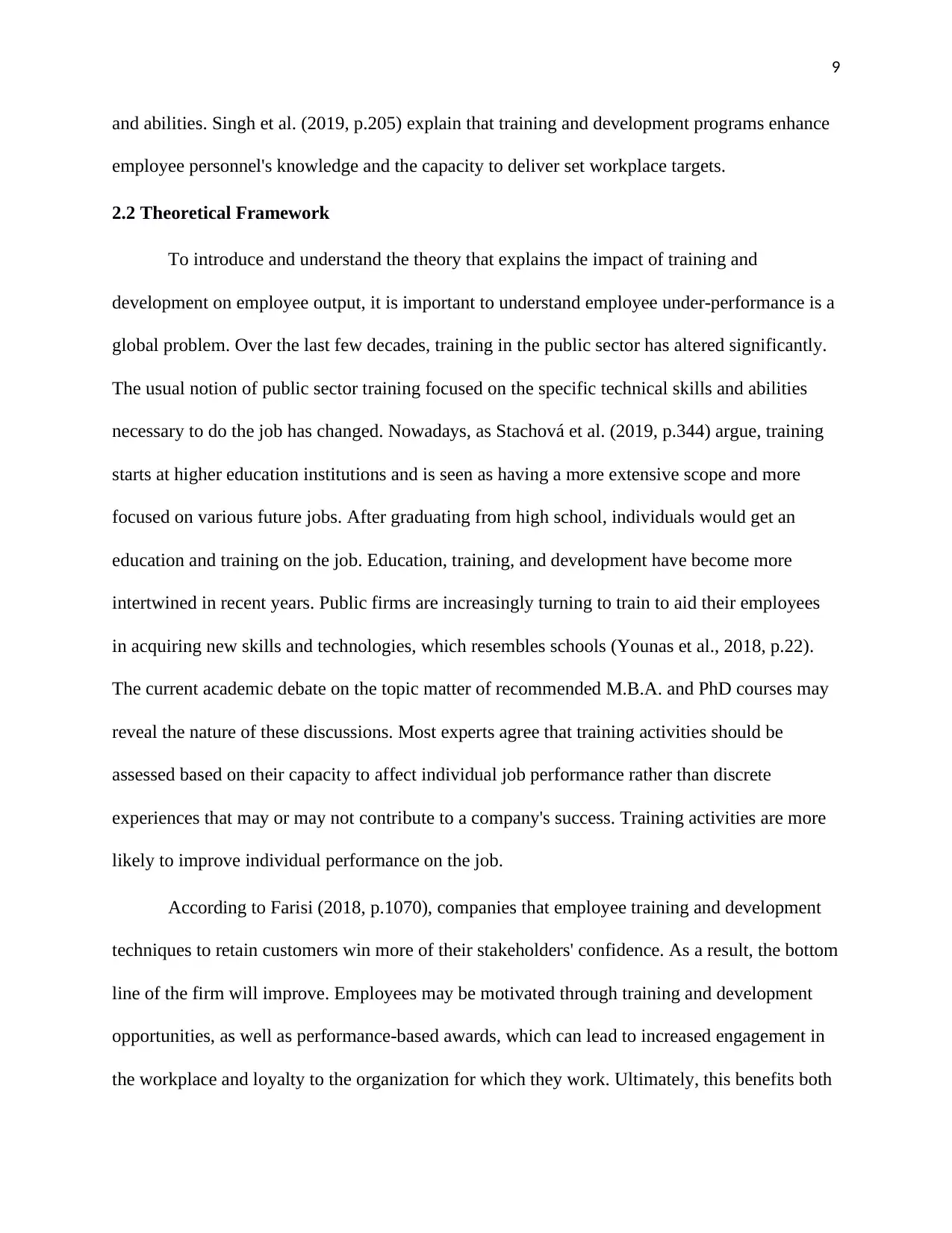
9
and abilities. Singh et al. (2019, p.205) explain that training and development programs enhance
employee personnel's knowledge and the capacity to deliver set workplace targets.
2.2 Theoretical Framework
To introduce and understand the theory that explains the impact of training and
development on employee output, it is important to understand employee under-performance is a
global problem. Over the last few decades, training in the public sector has altered significantly.
The usual notion of public sector training focused on the specific technical skills and abilities
necessary to do the job has changed. Nowadays, as Stachová et al. (2019, p.344) argue, training
starts at higher education institutions and is seen as having a more extensive scope and more
focused on various future jobs. After graduating from high school, individuals would get an
education and training on the job. Education, training, and development have become more
intertwined in recent years. Public firms are increasingly turning to train to aid their employees
in acquiring new skills and technologies, which resembles schools (Younas et al., 2018, p.22).
The current academic debate on the topic matter of recommended M.B.A. and PhD courses may
reveal the nature of these discussions. Most experts agree that training activities should be
assessed based on their capacity to affect individual job performance rather than discrete
experiences that may or may not contribute to a company's success. Training activities are more
likely to improve individual performance on the job.
According to Farisi (2018, p.1070), companies that employee training and development
techniques to retain customers win more of their stakeholders' confidence. As a result, the bottom
line of the firm will improve. Employees may be motivated through training and development
opportunities, as well as performance-based awards, which can lead to increased engagement in
the workplace and loyalty to the organization for which they work. Ultimately, this benefits both
and abilities. Singh et al. (2019, p.205) explain that training and development programs enhance
employee personnel's knowledge and the capacity to deliver set workplace targets.
2.2 Theoretical Framework
To introduce and understand the theory that explains the impact of training and
development on employee output, it is important to understand employee under-performance is a
global problem. Over the last few decades, training in the public sector has altered significantly.
The usual notion of public sector training focused on the specific technical skills and abilities
necessary to do the job has changed. Nowadays, as Stachová et al. (2019, p.344) argue, training
starts at higher education institutions and is seen as having a more extensive scope and more
focused on various future jobs. After graduating from high school, individuals would get an
education and training on the job. Education, training, and development have become more
intertwined in recent years. Public firms are increasingly turning to train to aid their employees
in acquiring new skills and technologies, which resembles schools (Younas et al., 2018, p.22).
The current academic debate on the topic matter of recommended M.B.A. and PhD courses may
reveal the nature of these discussions. Most experts agree that training activities should be
assessed based on their capacity to affect individual job performance rather than discrete
experiences that may or may not contribute to a company's success. Training activities are more
likely to improve individual performance on the job.
According to Farisi (2018, p.1070), companies that employee training and development
techniques to retain customers win more of their stakeholders' confidence. As a result, the bottom
line of the firm will improve. Employees may be motivated through training and development
opportunities, as well as performance-based awards, which can lead to increased engagement in
the workplace and loyalty to the organization for which they work. Ultimately, this benefits both
⊘ This is a preview!⊘
Do you want full access?
Subscribe today to unlock all pages.

Trusted by 1+ million students worldwide
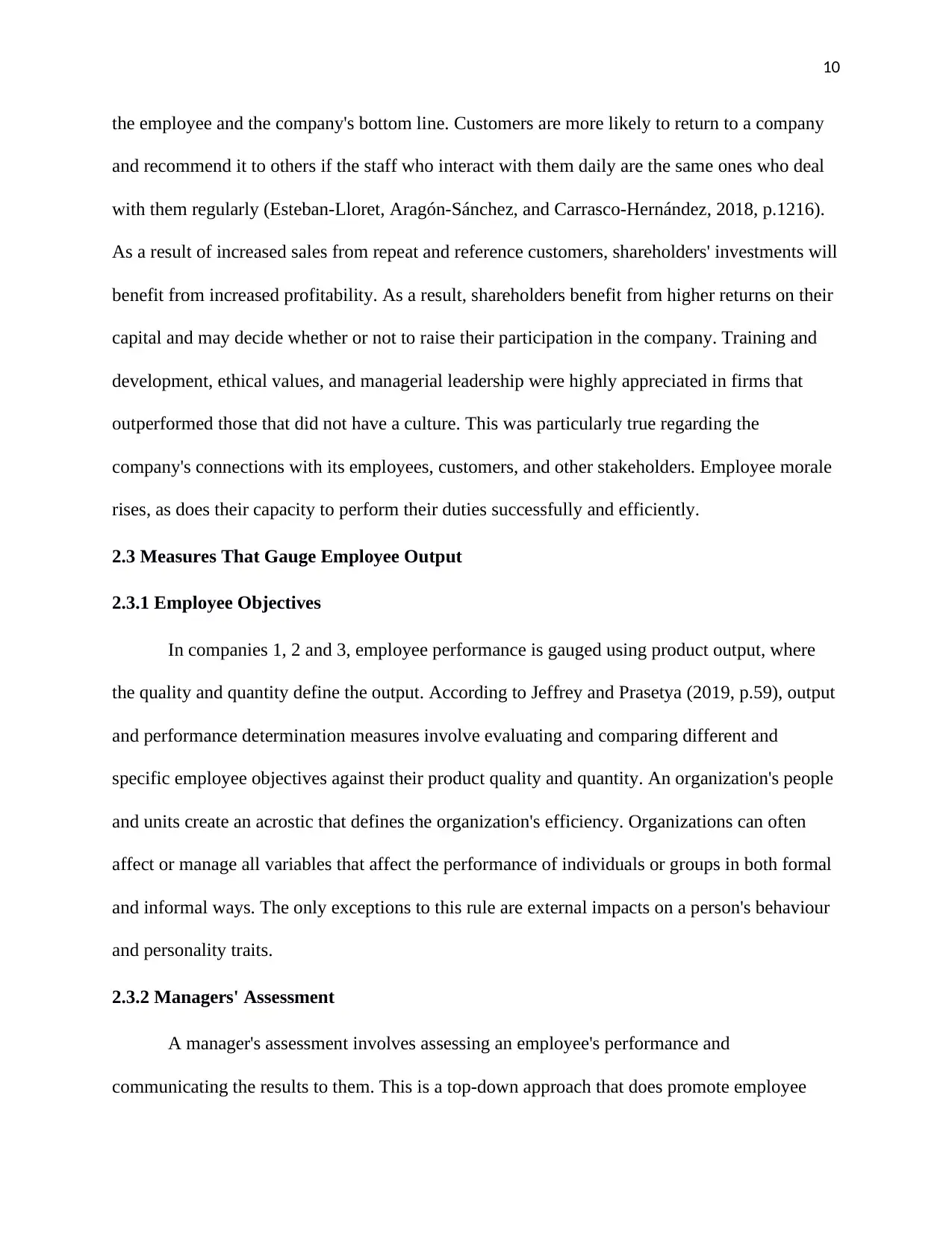
10
the employee and the company's bottom line. Customers are more likely to return to a company
and recommend it to others if the staff who interact with them daily are the same ones who deal
with them regularly (Esteban-Lloret, Aragón-Sánchez, and Carrasco-Hernández, 2018, p.1216).
As a result of increased sales from repeat and reference customers, shareholders' investments will
benefit from increased profitability. As a result, shareholders benefit from higher returns on their
capital and may decide whether or not to raise their participation in the company. Training and
development, ethical values, and managerial leadership were highly appreciated in firms that
outperformed those that did not have a culture. This was particularly true regarding the
company's connections with its employees, customers, and other stakeholders. Employee morale
rises, as does their capacity to perform their duties successfully and efficiently.
2.3 Measures That Gauge Employee Output
2.3.1 Employee Objectives
In companies 1, 2 and 3, employee performance is gauged using product output, where
the quality and quantity define the output. According to Jeffrey and Prasetya (2019, p.59), output
and performance determination measures involve evaluating and comparing different and
specific employee objectives against their product quality and quantity. An organization's people
and units create an acrostic that defines the organization's efficiency. Organizations can often
affect or manage all variables that affect the performance of individuals or groups in both formal
and informal ways. The only exceptions to this rule are external impacts on a person's behaviour
and personality traits.
2.3.2 Managers' Assessment
A manager's assessment involves assessing an employee's performance and
communicating the results to them. This is a top-down approach that does promote employee
the employee and the company's bottom line. Customers are more likely to return to a company
and recommend it to others if the staff who interact with them daily are the same ones who deal
with them regularly (Esteban-Lloret, Aragón-Sánchez, and Carrasco-Hernández, 2018, p.1216).
As a result of increased sales from repeat and reference customers, shareholders' investments will
benefit from increased profitability. As a result, shareholders benefit from higher returns on their
capital and may decide whether or not to raise their participation in the company. Training and
development, ethical values, and managerial leadership were highly appreciated in firms that
outperformed those that did not have a culture. This was particularly true regarding the
company's connections with its employees, customers, and other stakeholders. Employee morale
rises, as does their capacity to perform their duties successfully and efficiently.
2.3 Measures That Gauge Employee Output
2.3.1 Employee Objectives
In companies 1, 2 and 3, employee performance is gauged using product output, where
the quality and quantity define the output. According to Jeffrey and Prasetya (2019, p.59), output
and performance determination measures involve evaluating and comparing different and
specific employee objectives against their product quality and quantity. An organization's people
and units create an acrostic that defines the organization's efficiency. Organizations can often
affect or manage all variables that affect the performance of individuals or groups in both formal
and informal ways. The only exceptions to this rule are external impacts on a person's behaviour
and personality traits.
2.3.2 Managers' Assessment
A manager's assessment involves assessing an employee's performance and
communicating the results to them. This is a top-down approach that does promote employee
Paraphrase This Document
Need a fresh take? Get an instant paraphrase of this document with our AI Paraphraser
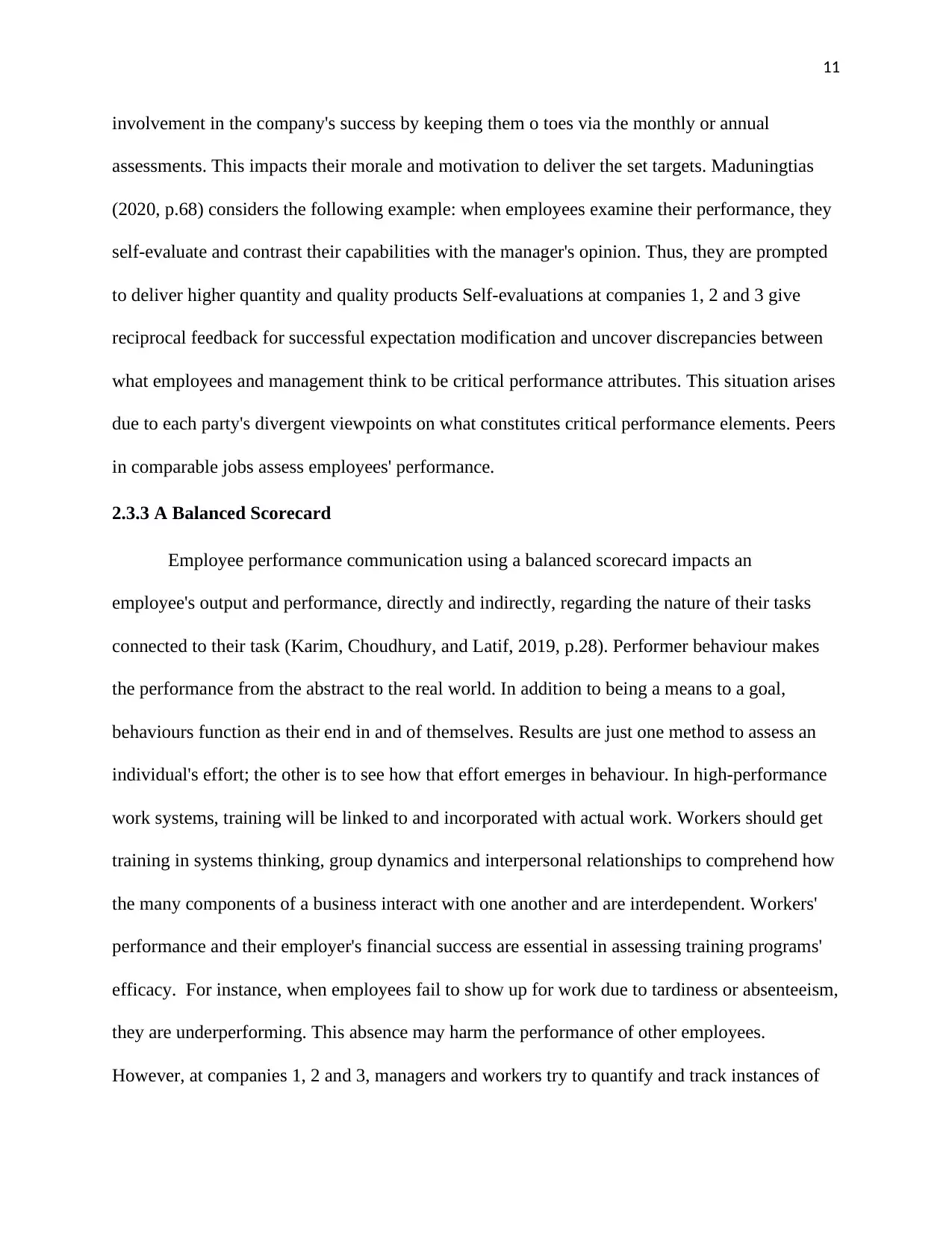
11
involvement in the company's success by keeping them o toes via the monthly or annual
assessments. This impacts their morale and motivation to deliver the set targets. Maduningtias
(2020, p.68) considers the following example: when employees examine their performance, they
self-evaluate and contrast their capabilities with the manager's opinion. Thus, they are prompted
to deliver higher quantity and quality products Self-evaluations at companies 1, 2 and 3 give
reciprocal feedback for successful expectation modification and uncover discrepancies between
what employees and management think to be critical performance attributes. This situation arises
due to each party's divergent viewpoints on what constitutes critical performance elements. Peers
in comparable jobs assess employees' performance.
2.3.3 A Balanced Scorecard
Employee performance communication using a balanced scorecard impacts an
employee's output and performance, directly and indirectly, regarding the nature of their tasks
connected to their task (Karim, Choudhury, and Latif, 2019, p.28). Performer behaviour makes
the performance from the abstract to the real world. In addition to being a means to a goal,
behaviours function as their end in and of themselves. Results are just one method to assess an
individual's effort; the other is to see how that effort emerges in behaviour. In high-performance
work systems, training will be linked to and incorporated with actual work. Workers should get
training in systems thinking, group dynamics and interpersonal relationships to comprehend how
the many components of a business interact with one another and are interdependent. Workers'
performance and their employer's financial success are essential in assessing training programs'
efficacy. For instance, when employees fail to show up for work due to tardiness or absenteeism,
they are underperforming. This absence may harm the performance of other employees.
However, at companies 1, 2 and 3, managers and workers try to quantify and track instances of
involvement in the company's success by keeping them o toes via the monthly or annual
assessments. This impacts their morale and motivation to deliver the set targets. Maduningtias
(2020, p.68) considers the following example: when employees examine their performance, they
self-evaluate and contrast their capabilities with the manager's opinion. Thus, they are prompted
to deliver higher quantity and quality products Self-evaluations at companies 1, 2 and 3 give
reciprocal feedback for successful expectation modification and uncover discrepancies between
what employees and management think to be critical performance attributes. This situation arises
due to each party's divergent viewpoints on what constitutes critical performance elements. Peers
in comparable jobs assess employees' performance.
2.3.3 A Balanced Scorecard
Employee performance communication using a balanced scorecard impacts an
employee's output and performance, directly and indirectly, regarding the nature of their tasks
connected to their task (Karim, Choudhury, and Latif, 2019, p.28). Performer behaviour makes
the performance from the abstract to the real world. In addition to being a means to a goal,
behaviours function as their end in and of themselves. Results are just one method to assess an
individual's effort; the other is to see how that effort emerges in behaviour. In high-performance
work systems, training will be linked to and incorporated with actual work. Workers should get
training in systems thinking, group dynamics and interpersonal relationships to comprehend how
the many components of a business interact with one another and are interdependent. Workers'
performance and their employer's financial success are essential in assessing training programs'
efficacy. For instance, when employees fail to show up for work due to tardiness or absenteeism,
they are underperforming. This absence may harm the performance of other employees.
However, at companies 1, 2 and 3, managers and workers try to quantify and track instances of
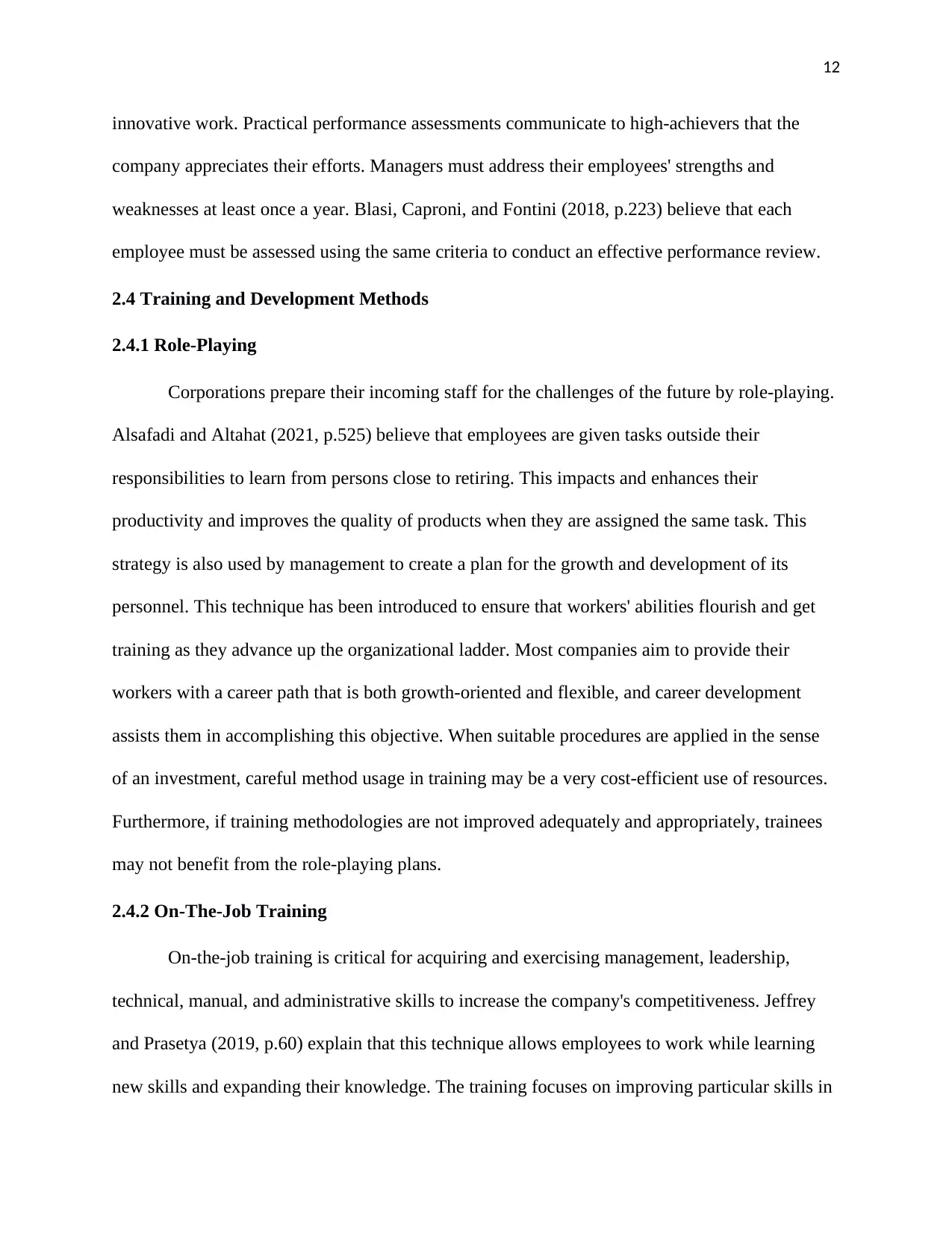
12
innovative work. Practical performance assessments communicate to high-achievers that the
company appreciates their efforts. Managers must address their employees' strengths and
weaknesses at least once a year. Blasi, Caproni, and Fontini (2018, p.223) believe that each
employee must be assessed using the same criteria to conduct an effective performance review.
2.4 Training and Development Methods
2.4.1 Role-Playing
Corporations prepare their incoming staff for the challenges of the future by role-playing.
Alsafadi and Altahat (2021, p.525) believe that employees are given tasks outside their
responsibilities to learn from persons close to retiring. This impacts and enhances their
productivity and improves the quality of products when they are assigned the same task. This
strategy is also used by management to create a plan for the growth and development of its
personnel. This technique has been introduced to ensure that workers' abilities flourish and get
training as they advance up the organizational ladder. Most companies aim to provide their
workers with a career path that is both growth-oriented and flexible, and career development
assists them in accomplishing this objective. When suitable procedures are applied in the sense
of an investment, careful method usage in training may be a very cost-efficient use of resources.
Furthermore, if training methodologies are not improved adequately and appropriately, trainees
may not benefit from the role-playing plans.
2.4.2 On-The-Job Training
On-the-job training is critical for acquiring and exercising management, leadership,
technical, manual, and administrative skills to increase the company's competitiveness. Jeffrey
and Prasetya (2019, p.60) explain that this technique allows employees to work while learning
new skills and expanding their knowledge. The training focuses on improving particular skills in
innovative work. Practical performance assessments communicate to high-achievers that the
company appreciates their efforts. Managers must address their employees' strengths and
weaknesses at least once a year. Blasi, Caproni, and Fontini (2018, p.223) believe that each
employee must be assessed using the same criteria to conduct an effective performance review.
2.4 Training and Development Methods
2.4.1 Role-Playing
Corporations prepare their incoming staff for the challenges of the future by role-playing.
Alsafadi and Altahat (2021, p.525) believe that employees are given tasks outside their
responsibilities to learn from persons close to retiring. This impacts and enhances their
productivity and improves the quality of products when they are assigned the same task. This
strategy is also used by management to create a plan for the growth and development of its
personnel. This technique has been introduced to ensure that workers' abilities flourish and get
training as they advance up the organizational ladder. Most companies aim to provide their
workers with a career path that is both growth-oriented and flexible, and career development
assists them in accomplishing this objective. When suitable procedures are applied in the sense
of an investment, careful method usage in training may be a very cost-efficient use of resources.
Furthermore, if training methodologies are not improved adequately and appropriately, trainees
may not benefit from the role-playing plans.
2.4.2 On-The-Job Training
On-the-job training is critical for acquiring and exercising management, leadership,
technical, manual, and administrative skills to increase the company's competitiveness. Jeffrey
and Prasetya (2019, p.60) explain that this technique allows employees to work while learning
new skills and expanding their knowledge. The training focuses on improving particular skills in
⊘ This is a preview!⊘
Do you want full access?
Subscribe today to unlock all pages.

Trusted by 1+ million students worldwide
1 out of 28
Related Documents
Your All-in-One AI-Powered Toolkit for Academic Success.
+13062052269
info@desklib.com
Available 24*7 on WhatsApp / Email
![[object Object]](/_next/static/media/star-bottom.7253800d.svg)
Unlock your academic potential
Copyright © 2020–2025 A2Z Services. All Rights Reserved. Developed and managed by ZUCOL.




